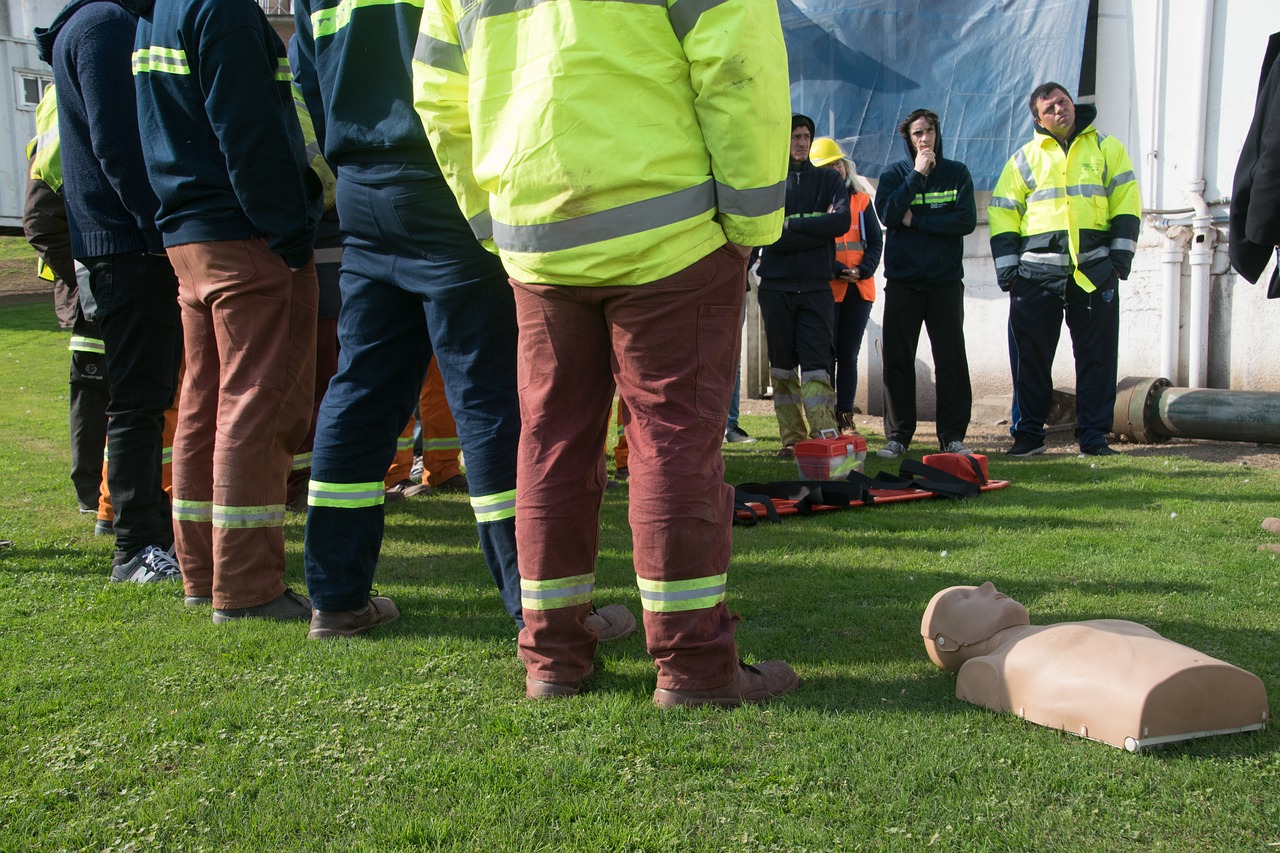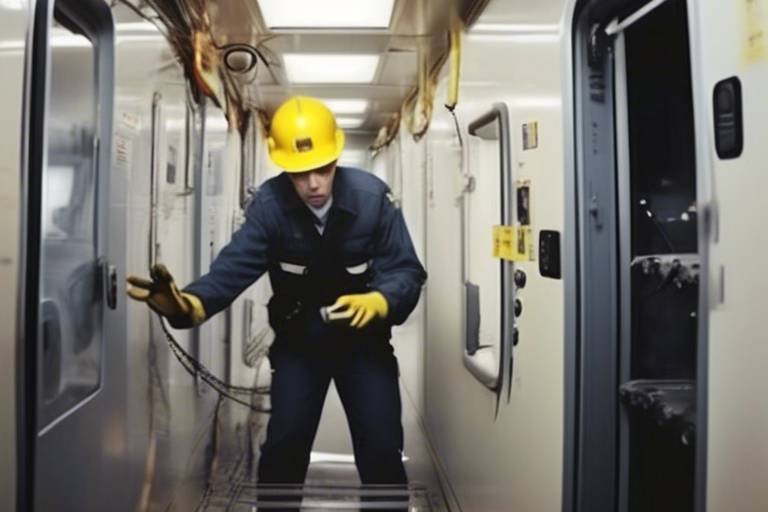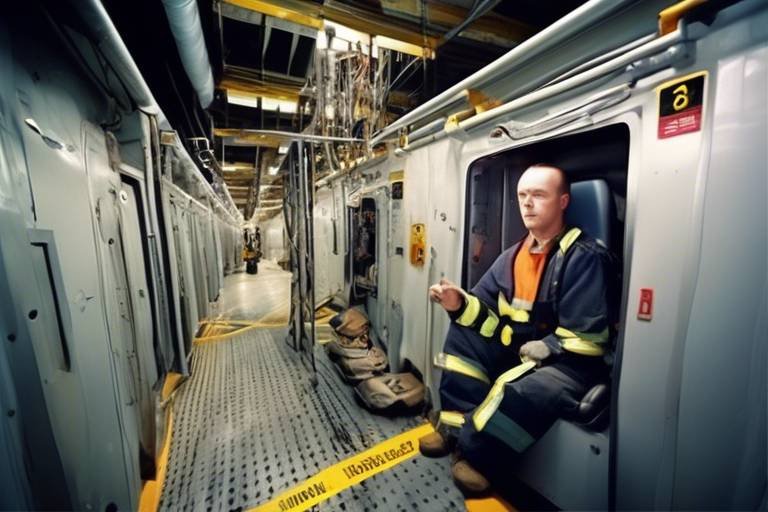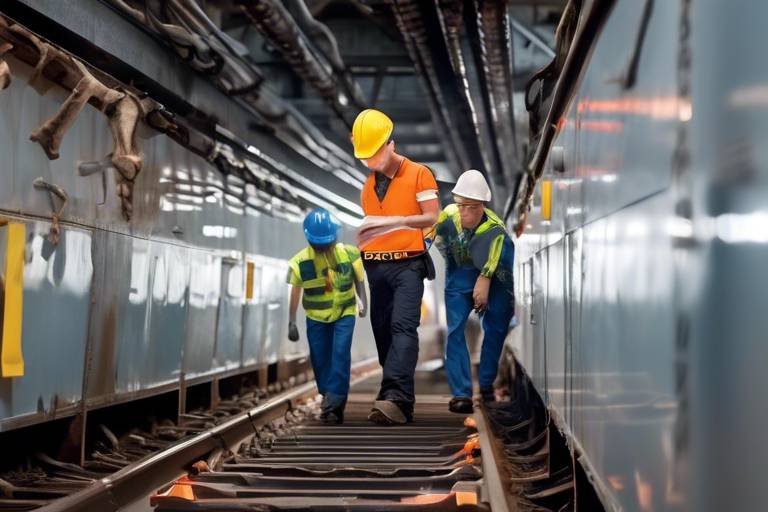The Implications of Human Behavior on Safety Standards
In our fast-paced world, the significance of human behavior on safety standards cannot be overstated. Imagine a bustling construction site or a busy hospital—each setting is teeming with potential hazards. Yet, what often determines the level of safety is not just the equipment or protocols in place, but the decisions and actions of individuals. This article explores how our behaviors, perceptions, and cultural contexts intertwine to shape safety standards across various industries. By understanding these dynamics, we can pave the way for a safer environment for everyone.
Compliance serves as the backbone of safety standards in any organization. It’s like the rules of a game; without them, chaos reigns. When employees adhere to regulations and guidelines, they contribute to a culture of safety that not only protects them but also their colleagues. Understanding the importance of compliance is crucial. It ensures that everyone is on the same page, working towards a common goal of safety. However, compliance is not merely about following rules; it’s about fostering an environment where safety becomes second nature. Organizations that prioritize compliance often see a remarkable transformation in their safety records, leading to fewer accidents and a more engaged workforce.
Risk perception is a fascinating aspect of human behavior that significantly influences how individuals respond to safety protocols. Have you ever noticed how some people seem to underestimate risks while others overreact? This variance can be attributed to psychological factors that shape our understanding of danger. For instance, in high-stakes environments such as aviation or healthcare, the way risks are perceived can dictate whether safety measures are followed diligently or ignored. Understanding these psychological aspects is essential for developing effective safety training programs and communication strategies that resonate with employees.
Cultural factors are pivotal in shaping safety behaviors. Imagine a workplace where safety is woven into the very fabric of its culture—where employees feel empowered to speak up about unsafe practices. In contrast, in cultures where safety is an afterthought, the consequences can be dire. Societal norms and values play a critical role in how individuals and organizations approach safety. For instance, in some cultures, there’s a strong emphasis on hierarchy, which might discourage lower-level employees from voicing safety concerns. Understanding these cultural nuances can help organizations tailor their safety protocols to better fit their workforce.
Effective training programs are the cornerstone of enhancing safety awareness. Think of training as the compass that guides employees through the complex landscape of safety protocols. When organizations invest in comprehensive training, they equip their employees with the knowledge and skills necessary to navigate potential hazards. This education not only improves compliance but also fosters a culture where safety is prioritized. It’s essential to regularly update training materials and methods to ensure they resonate with employees and address the latest safety challenges.
Open communication is the lifeblood of a strong safety culture. When employees feel comfortable discussing safety issues, it leads to a more proactive approach to risk management. Imagine a scenario where a worker notices a potential hazard but hesitates to report it due to fear of backlash. This silence can lead to accidents that could have been easily prevented. By fostering an environment of open dialogue, organizations can address behavioral issues and promote safety practices that resonate with employees at all levels.
Behavioral economics offers valuable insights into the decision-making processes surrounding safety compliance. It examines how economic factors, such as incentives and penalties, influence individuals' adherence to safety protocols. For example, when organizations implement reward systems for safe practices, it can significantly boost compliance rates. Understanding these economic motivators allows organizations to design strategies that encourage safe behaviors while minimizing risks.
An organization’s culture directly impacts its safety standards. Think of culture as the soil in which safety practices grow. If the soil is rich and nurtured, safety thrives; if it’s neglected, safety falters. Leadership plays a crucial role in cultivating this culture. When leaders prioritize safety and engage employees in safety initiatives, it fosters a sense of ownership and responsibility among the workforce. This engagement is vital for creating a lasting culture of safety that benefits everyone.
Effective leadership is essential for fostering a safe work environment. Leaders set the tone for safety culture by modeling safe behaviors and encouraging open communication. They can implement strategies such as regular safety meetings, feedback sessions, and recognition programs to promote a culture of safety. When employees see their leaders actively participating in safety initiatives, it reinforces the message that safety is a shared responsibility.
Engaged employees are more likely to prioritize safety. Think about it—when employees feel valued and involved, they take greater ownership of their work, including safety practices. Organizations can enhance employee involvement by soliciting feedback, encouraging participation in safety committees, and recognizing safe behaviors. The positive outcomes of such engagement are profound, leading to fewer accidents and a more cohesive workforce.
- What is the importance of compliance in safety standards?
Compliance ensures that safety protocols are followed, reducing the risk of accidents and injuries. - How does risk perception affect safety behavior?
Risk perception influences how individuals respond to safety measures, impacting their likelihood of following protocols. - What role does culture play in safety practices?
Cultural norms shape how safety is prioritized and addressed within organizations. - How can training improve safety awareness?
Effective training equips employees with the knowledge and skills to recognize and mitigate risks.

The Role of Compliance in Safety Standards
Understanding the importance of compliance is crucial for maintaining safety standards across various industries. Compliance refers to the adherence to established regulations, guidelines, and protocols that are designed to protect individuals and ensure a safe working environment. But why is compliance so vital? Think of it as the backbone of safety; without it, the entire structure can crumble, leading to catastrophic consequences.
When organizations prioritize compliance, they not only protect their employees but also enhance their reputation and operational efficiency. For instance, companies that rigorously follow safety regulations tend to experience fewer accidents and injuries, which in turn reduces costs associated with workers' compensation and legal liabilities. This compliance-driven approach fosters a culture of safety that permeates every level of the organization.
However, compliance is not just about following rules; it’s about creating a mindset where safety is valued. Employees must understand the regulations and the rationale behind them. This is where effective communication comes into play. Organizations should invest in comprehensive training programs that not only inform employees about safety standards but also engage them in discussions about their importance. For example:
| Training Topic | Objective |
|---|---|
| Understanding Safety Regulations | To familiarize employees with applicable laws and standards. |
| Risk Assessment Techniques | To equip employees with skills to identify and mitigate risks. |
| Emergency Response Procedures | To prepare employees for potential emergencies effectively. |
Moreover, compliance is often influenced by an organization's culture. A culture that values safety encourages employees to speak up about potential hazards and compliance issues. When employees feel comfortable reporting unsafe conditions without fear of retribution, organizations can address problems before they escalate. In this way, compliance becomes a shared responsibility rather than a top-down mandate.
In summary, compliance is not merely a checkbox to tick off; it is a dynamic process that requires ongoing commitment from both management and employees. By fostering a culture of compliance, organizations can create a safer workplace that benefits everyone involved. The result? A thriving environment where safety is prioritized, and everyone plays a part in maintaining it.

The Impact of Risk Perception
Risk perception is a fascinating concept that profoundly affects how we interact with safety protocols. Imagine you're driving a car; your perception of risk influences whether you buckle up, obey speed limits, or even check your mirrors. In high-stakes environments like construction sites or hospitals, the stakes are even higher. Individuals often assess risks based on personal experiences, societal influences, and even media portrayals. This subjective evaluation can lead to significant discrepancies in how safety measures are implemented and followed.
One of the core elements of risk perception is the psychological aspect. People tend to underestimate risks they are familiar with while overestimating the dangers of less familiar situations. For instance, a seasoned construction worker may feel confident working at heights, believing that their experience minimizes the risk. In contrast, a newcomer might see the same situation as perilous, leading to different behaviors regarding safety protocols. This disparity can create a challenging environment where safety compliance is inconsistent, ultimately affecting the overall safety culture.
Moreover, the availability heuristic plays a crucial role in risk perception. This cognitive bias leads individuals to rely on immediate examples that come to mind when evaluating a specific risk. If someone has recently heard about a workplace accident, they may become overly cautious, leading to unnecessary anxiety and potentially inhibiting productivity. Conversely, if they have not encountered any incidents in a while, they might become complacent, neglecting safety measures altogether. This fluctuation in risk perception can create a rollercoaster of safety attitudes within an organization.
To illustrate this further, consider the following table that outlines various factors influencing risk perception:
| Factor | Description |
|---|---|
| Personal Experience | Past encounters with risk shape how individuals perceive and react to similar situations. |
| Media Influence | News reports and social media can amplify certain risks, skewing public perception. |
| Social Norms | Community attitudes towards safety can either reinforce or diminish compliance with safety standards. |
| Training and Education | Proper training can enhance awareness and understanding of risks, leading to better compliance. |
Understanding these factors is critical for organizations aiming to improve their safety standards. By addressing the psychological components of risk perception, companies can tailor their safety training programs to better resonate with employees. For example, incorporating real-life scenarios and engaging storytelling can help bridge the gap between perception and reality, ensuring that employees recognize the importance of adhering to safety protocols.
Additionally, fostering an environment where employees feel comfortable discussing their perceptions of risk can lead to greater transparency and improved safety practices. Open dialogues about safety concerns can help organizations identify misconceptions and address them proactively. After all, when employees feel heard, they are more likely to engage in safe practices and encourage their peers to do the same.
In conclusion, risk perception is not just a psychological phenomenon; it has tangible effects on safety compliance and organizational culture. By understanding and addressing the factors that influence how individuals perceive risk, organizations can create a safer work environment for everyone involved. It's not just about following rules; it's about building a culture where safety is valued and prioritized, ultimately leading to better outcomes for all.
- What is risk perception? Risk perception refers to how individuals interpret and evaluate the risks associated with specific situations, which can significantly influence their behavior towards safety protocols.
- How does personal experience affect risk perception? Personal experiences shape how individuals view risks; those who have encountered specific dangers may either become more cautious or overly confident in similar situations.
- Why is it important to address risk perception in safety training? Addressing risk perception in safety training helps employees understand the real dangers they face, leading to better compliance with safety standards and practices.

Cultural influences play a crucial role in shaping safety behaviors within any organization. When we talk about culture, we're not just referring to the traditions or customs of a group; we're diving into the very fabric of how people think, act, and interact with one another in a workplace setting. Imagine a workplace as a garden—its growth and health depend on various factors, from the soil (organizational policies) to the sunlight (leadership) and, importantly, the seeds (individual behaviors) that are sown. If the seeds are influenced by a rich cultural background that prioritizes safety, the garden will flourish. Conversely, if the seeds are sown in a culture that neglects safety, the garden will struggle to thrive.
For instance, in cultures where safety is viewed as a shared responsibility, employees are more likely to engage in proactive safety behaviors. They understand that their actions impact not just themselves but also their colleagues. This sense of communal responsibility can lead to a stronger adherence to safety protocols and a more vigilant approach to identifying potential hazards. On the other hand, in cultures that prioritize productivity over safety, employees may feel pressured to overlook safety concerns in favor of meeting deadlines or achieving performance targets. This can create a dangerous environment where risks are underestimated, and accidents become more likely.
Moreover, cultural norms dictate how individuals perceive authority and communicate within the workplace. In hierarchical cultures, employees may hesitate to report safety issues or suggest improvements for fear of upsetting superiors. This can lead to a lack of transparency in safety practices, where problems are swept under the rug rather than addressed openly. Conversely, in cultures that encourage open dialogue and feedback, employees feel empowered to voice their concerns and contribute to safety initiatives. This open communication fosters a collaborative approach to safety, where everyone plays a part in creating a safer work environment.
It's also essential to recognize that cultural influences are not static; they evolve over time. Organizations that actively promote a culture of safety through training, recognition, and open communication can shift the mindset of their workforce. For example, implementing regular safety drills and celebrating safety achievements can reinforce the importance of safety in the organizational culture. This not only enhances awareness but also instills a sense of pride among employees, as they see their commitment to safety recognized and valued.
In summary, cultural influences significantly shape safety behavior in the workplace. By understanding the dynamics of culture, organizations can implement strategies that foster a safety-oriented mindset among employees. This cultural shift is not merely a top-down initiative; it requires engagement at all levels, encouraging individuals to take ownership of their safety and that of their colleagues. The result is a safer, more productive workplace where everyone can thrive.
- How does organizational culture impact safety behavior? Organizational culture sets the tone for how safety is perceived and prioritized. A strong safety culture encourages proactive behaviors and open communication.
- What role does leadership play in shaping safety culture? Leadership is vital in modeling safety behaviors, setting expectations, and fostering an environment where safety is a shared responsibility.
- Can cultural influences change over time? Yes, cultural influences can evolve as organizations implement new policies, training programs, and initiatives that promote safety awareness.
- How can employees contribute to a safer workplace? Employees can contribute by actively engaging in safety initiatives, reporting hazards, and participating in training programs.

When it comes to safety, training and education are not just important—they're absolutely essential. Imagine a world where workers are equipped with the knowledge and skills to recognize hazards and respond appropriately. This is the reality that effective training programs strive to create. By investing time and resources into comprehensive safety training, organizations can significantly enhance their workforce's awareness and compliance with safety standards.
One of the key aspects of safety training is its ability to reshape behaviors. When employees understand the reasons behind safety protocols, they are more likely to embrace these practices as part of their daily routines. For instance, consider a construction site where workers are trained not only on how to wear personal protective equipment (PPE) but also on the risks associated with failing to do so. This knowledge fosters a culture of safety where individuals are more vigilant and proactive in protecting themselves and their colleagues.
Moreover, ongoing education plays a pivotal role in keeping safety at the forefront of employees' minds. It's not enough to conduct a one-time training session; continuous learning opportunities ensure that safety remains a priority. Regular workshops, refresher courses, and updates on new safety regulations can help reinforce the importance of compliance and adapt to changes in the work environment. For example, in industries like healthcare, where protocols can evolve rapidly, staying informed is crucial for both patient and employee safety.
To illustrate the impact of training on safety behavior, consider the following table that highlights the correlation between training frequency and incident reduction:
| Training Frequency | Incident Rate (per 100 employees) |
|---|---|
| Once a year | 15 |
| Twice a year | 10 |
| Quarterly | 5 |
| Monthly | 2 |
This table clearly demonstrates that as training frequency increases, incident rates decrease. This correlation underscores the necessity for organizations to prioritize regular training sessions as part of their safety strategy.
In addition to technical skills, training programs should also emphasize soft skills such as communication and teamwork. These skills are vital in fostering a collaborative safety culture where employees feel empowered to speak up about potential hazards. When team members are trained to communicate openly, they can share insights and experiences that might otherwise go unnoticed, ultimately leading to a safer working environment.
Ultimately, the impact of training and education on behavior is profound. By fostering an environment where safety is prioritized and valued, organizations can cultivate a workforce that not only understands the importance of safety standards but actively participates in maintaining them. This proactive approach not only protects employees but also enhances overall organizational performance.
- Why is training important for safety compliance?
Training equips employees with the necessary skills and knowledge to recognize and mitigate risks, thereby reducing the likelihood of accidents. - How often should safety training be conducted?
Regular training sessions, ideally on a quarterly or monthly basis, help reinforce safety practices and keep employees informed about any changes in regulations or procedures. - What role does communication play in safety training?
Effective communication fosters a culture of safety where employees feel comfortable discussing hazards and safety practices, leading to a more proactive approach to safety.

When we talk about communication in the context of safety culture, it’s like discussing the oil that keeps the machinery running smoothly. Without effective communication, even the best safety protocols can fall flat, leading to misunderstandings and, ultimately, unsafe environments. Imagine a workplace where employees are hesitant to voice their concerns or report hazards—it's a recipe for disaster. Communication is not just about passing information; it's about creating an atmosphere where everyone feels empowered to speak up.
Effective communication serves as the backbone of a robust safety culture. It fosters trust and transparency, allowing employees to feel comfortable sharing their thoughts and experiences. When team members are encouraged to discuss safety openly, it leads to a greater understanding of potential risks and promotes collective problem-solving. For instance, when a worker spots a potential hazard, an open line of communication ensures that the issue is addressed promptly, preventing accidents before they occur.
Moreover, organizations that prioritize communication often see a marked improvement in their safety performance. Studies have shown that when employees are engaged in safety discussions, they are more likely to adhere to safety protocols. This engagement can be achieved through regular safety meetings, feedback sessions, and even informal discussions during breaks. The key is to create a culture where safety is a shared responsibility and communication flows freely in all directions—from leadership down to the frontline workers.
However, fostering this kind of environment requires intentional effort. Leaders must model effective communication practices and actively encourage their teams to participate in safety dialogues. This includes not just talking about safety but also listening to what employees have to say. When leaders show that they value input from their teams, it reinforces the idea that safety is a priority for everyone involved.
To illustrate the importance of communication in safety culture, consider the following table that outlines the elements of effective safety communication:
| Element | Description |
|---|---|
| Clarity | Messages should be clear and easily understood to avoid confusion. |
| Consistency | Regular updates and consistent messaging reinforce safety priorities. |
| Inclusivity | Encouraging input from all levels of staff fosters a sense of belonging and responsibility. |
| Feedback | Providing avenues for feedback allows for continuous improvement in safety practices. |
In conclusion, the relationship between communication and safety culture is undeniable. By fostering an environment where open dialogue is encouraged, organizations can significantly enhance their safety standards. It’s about building a community where everyone feels responsible for safety—because when it comes down to it, safety is everyone's job. So, let’s make sure we keep those lines of communication open!
- Why is communication important for safety culture? Communication is vital as it promotes transparency, trust, and collective problem-solving, which are essential for identifying and mitigating risks.
- How can organizations improve communication regarding safety? Organizations can improve communication by holding regular safety meetings, encouraging feedback, and fostering an inclusive environment where all employees feel comfortable voicing their concerns.
- What role do leaders play in fostering a safety culture? Leaders play a crucial role by modeling effective communication practices, actively engaging with employees, and demonstrating that safety is a priority for the organization.

Behavioral economics is a fascinating field that merges psychology with economic theory, providing us with profound insights into how individuals make decisions, particularly in the context of safety compliance. At its core, it challenges the traditional notion that people always act rationally and in their best interest. Instead, it highlights that our choices are often influenced by cognitive biases, emotions, and social factors. This is particularly important in high-stakes environments, such as construction sites or healthcare facilities, where the consequences of poor safety compliance can be dire.
One of the key concepts in behavioral economics is the idea of loss aversion. This principle suggests that people tend to prefer avoiding losses rather than acquiring equivalent gains. In the context of safety compliance, this means that if employees perceive the potential losses from not following safety protocols as greater than the inconvenience of adhering to them, they are more likely to comply. For instance, if workers understand that neglecting safety measures could lead to severe injuries or fatalities, they might be more inclined to follow the rules strictly. This highlights the importance of effectively communicating the risks associated with non-compliance.
Additionally, social norms play a critical role in shaping safety behaviors. When individuals observe their peers adhering to safety protocols, they are more likely to follow suit. This is where the concept of social proof comes into play. If an organization promotes a culture where safety compliance is the norm, employees will feel a sense of obligation to conform to those behaviors. Organizations can leverage this by showcasing stories of safe practices and recognizing employees who exemplify safety-first attitudes. By creating an environment where safety is celebrated, organizations can enhance compliance rates significantly.
Moreover, the design of safety protocols and the way they are presented can greatly influence compliance. Behavioral economics suggests that simplifying complex safety procedures can lead to higher adherence rates. For example, if safety guidelines are presented in a clear, concise manner—perhaps through infographics or quick-reference cards—employees are more likely to understand and follow them. This aligns with the principle of framing, which posits that the way information is presented can significantly impact decision-making. By framing safety compliance as a straightforward and manageable task, organizations can reduce the cognitive load on employees and encourage better adherence.
To illustrate these concepts further, consider the following table that summarizes key behavioral economics principles related to safety compliance:
| Principle | Description | Implication for Safety Compliance |
|---|---|---|
| Loss Aversion | People prefer to avoid losses over acquiring gains. | Highlighting the risks of non-compliance can motivate adherence to safety protocols. |
| Social Proof | Individuals are influenced by the behaviors of their peers. | Promoting a culture of safety can encourage employees to comply with safety measures. |
| Framing | The presentation of information affects decision-making. | Clear and simple safety guidelines can enhance understanding and compliance. |
In conclusion, integrating insights from behavioral economics into safety compliance strategies can lead to more effective outcomes. By understanding the psychological factors that influence decision-making, organizations can create environments that not only promote adherence to safety standards but also foster a culture of safety. This ultimately leads to a safer workplace for everyone involved, reducing accidents and enhancing overall productivity.
- What is behavioral economics? Behavioral economics is a field that combines psychology and economic theory to understand how individuals make decisions, particularly in contexts like safety compliance.
- How does loss aversion affect safety compliance? Loss aversion suggests that individuals are more motivated to avoid losses than to achieve gains, making them more likely to comply with safety measures when they understand the risks of non-compliance.
- What role do social norms play in safety behavior? Social norms influence individuals to follow the behaviors of their peers. A strong safety culture can encourage compliance as employees strive to align with the safe practices of their colleagues.
- How can organizations improve safety compliance? Organizations can improve safety compliance by simplifying safety protocols, effectively communicating risks, and fostering a culture that celebrates safe behaviors.

When we talk about safety in the workplace, one of the most critical factors that often gets overlooked is organizational culture. This culture is like the invisible glue that holds everything together, influencing how employees think, feel, and act regarding safety practices. Imagine a ship sailing through stormy seas; if the crew isn't aligned and working together, even the sturdiest vessel can capsize. Similarly, a strong safety culture can steer an organization clear of hazards and accidents.
At its core, organizational culture encompasses the values, beliefs, and behaviors that shape how employees interact and work together. When it comes to safety, this culture can either propel an organization toward a safer environment or lead it into turbulent waters. A positive culture encourages open communication, where employees feel comfortable discussing safety concerns without fear of repercussions. In contrast, a toxic culture may foster silence and complacency, leading to a higher likelihood of accidents.
To illustrate this point, let’s consider two companies: Company A and Company B. Company A has invested time and resources into building a culture of safety. They conduct regular safety meetings, encourage feedback from employees, and recognize those who go above and beyond to promote safety. As a result, they have significantly lower accident rates and higher employee morale. On the other hand, Company B neglects safety culture, viewing it as a mere checkbox on a compliance list. Employees at Company B are hesitant to report unsafe conditions, fearing backlash or indifference from management. Consequently, their accident rates are alarmingly high, leading to costly repercussions.
So, how can organizations cultivate a culture of safety? Here are some essential strategies:
- Leadership Commitment: Leaders must model safe behaviors and prioritize safety in their decision-making processes. When employees see their leaders genuinely care about safety, they are more likely to follow suit.
- Employee Involvement: Engaging employees in safety initiatives creates a sense of ownership. When team members contribute to safety protocols, they are more invested in adhering to them.
- Continuous Improvement: Safety is not a one-time effort; it requires ongoing evaluation and adjustment. Organizations should regularly assess their safety practices and be open to change.
By nurturing a robust organizational culture centered around safety, companies can not only protect their employees but also enhance productivity and overall morale. Employees who feel safe and valued tend to be more engaged, leading to better performance and a more harmonious workplace.
In conclusion, the relationship between organizational culture and safety is undeniable. Just as a tree needs strong roots to grow tall and healthy, an organization needs a solid safety culture to thrive. By prioritizing this culture, businesses can create an environment where safety is woven into the very fabric of their operations.
Q1: How can I assess my organization's safety culture?
A1: You can assess your safety culture through employee surveys, safety audits, and by observing workplace behaviors. Engaging employees in discussions about safety can also provide valuable insights.
Q2: What are some signs of a poor safety culture?
A2: Signs of a poor safety culture include high accident rates, reluctance to report incidents, lack of communication about safety, and a general atmosphere of fear or indifference towards safety protocols.
Q3: How can leadership influence safety culture?
A3: Leadership can influence safety culture by demonstrating commitment to safety, providing necessary resources and training, and encouraging open dialogue about safety concerns.

When it comes to creating a culture of safety within an organization, leadership plays a pivotal role. Imagine a ship navigating through stormy seas; the captain's decisions and actions determine whether the crew remains safe or faces peril. Similarly, leaders set the tone for safety practices and behaviors in the workplace. They are not just figureheads; they are the ones who can inspire, motivate, and influence their teams to prioritize safety above all else.
One of the key responsibilities of leaders is to establish clear safety policies and procedures. This involves not only creating these guidelines but also ensuring that they are communicated effectively throughout the organization. A well-structured safety program should include regular training sessions that keep everyone informed about the latest safety protocols. When leaders actively participate in these sessions, it sends a strong message: “Safety is everyone’s responsibility.”
Furthermore, effective leaders lead by example. They embody the safety standards they wish to see in their teams. If a leader consistently follows safety protocols, wears protective gear, and prioritizes safe practices, employees are more likely to mirror that behavior. This concept is often referred to as “walking the talk.” When leaders demonstrate their commitment to safety, it cultivates an environment where employees feel empowered to speak up about safety concerns without fear of retaliation.
Another crucial aspect of leadership in promoting safety is fostering open communication. Leaders should encourage a culture where feedback is welcomed and valued. This can be achieved through regular safety meetings, suggestion boxes, or even informal check-ins. An open-door policy can significantly enhance communication, allowing employees to voice their concerns and share ideas for improving safety practices. When employees feel heard, they are more likely to engage actively in safety initiatives.
To further illustrate the importance of leadership in safety, consider the following table that highlights key leadership behaviors that promote a culture of safety:
| Leadership Behavior | Impact on Safety Culture |
|---|---|
| Leading by Example | Encourages employees to adopt safe practices |
| Open Communication | Fosters trust and encourages reporting of safety issues |
| Regular Training | Keeps employees informed and prepared for potential hazards |
| Recognition of Safe Behavior | Motivates employees to prioritize safety |
Additionally, leaders should recognize and reward safe behavior among employees. Acknowledging individuals or teams who consistently adhere to safety protocols not only boosts morale but also reinforces the importance of safety in the workplace. This recognition can take many forms, from verbal praise during meetings to formal awards or incentives. When employees see that their safe actions are valued, it motivates them to continue prioritizing safety.
In conclusion, the role of leadership in promoting safety cannot be overstated. Leaders have the power to create an environment where safety is embedded in the organizational culture. By leading by example, fostering open communication, providing regular training, and recognizing safe behaviors, leaders can significantly enhance safety standards within their organizations. Remember, a safe workplace is not just a goal; it’s a journey that requires commitment and collaboration from everyone involved.
- What is the most important role of a leader in promoting safety? The most important role is to lead by example and create a culture where safety is prioritized and valued.
- How can leaders encourage open communication about safety? By fostering an environment where feedback is welcomed, implementing regular safety meetings, and maintaining an open-door policy.
- What are effective ways to recognize safe behavior? Leaders can recognize safe behavior through verbal praise, awards, and incentives that highlight employees’ commitment to safety.

When it comes to ensuring a safe work environment, employee engagement plays a pivotal role that cannot be overlooked. Engaged employees are not just more productive; they are also more likely to prioritize safety in their daily tasks. Why is that? Well, when employees feel connected to their organization and its goals, they tend to take ownership of their roles, including adhering to safety protocols. This sense of responsibility can lead to a significant reduction in workplace accidents and injuries.
Imagine a workplace where every employee is actively involved in safety practices. This isn’t just a dream; it’s a reality that can be achieved through effective engagement strategies. For instance, organizations can implement regular safety meetings where employees are encouraged to share their experiences and insights. These meetings can serve as a platform for discussing potential hazards and brainstorming solutions, thereby fostering a culture of safety. Additionally, when employees see that their input is valued, they are more likely to contribute positively to safety initiatives.
Moreover, incorporating safety into the organization's core values is essential. When safety is recognized as a fundamental aspect of the company culture, employees are more likely to embrace it. This can be achieved by:
- Providing ongoing safety training and resources.
- Recognizing and rewarding safe behaviors.
- Encouraging open communication about safety concerns.
To further enhance engagement, organizations can also utilize technology. For example, mobile apps can be developed to allow employees to report hazards or unsafe conditions in real-time. This not only empowers employees but also demonstrates that the organization is committed to their safety. By leveraging technology, companies can create a more responsive and proactive safety culture.
Another effective strategy is to involve employees in the development of safety policies. When employees have a say in how safety is managed, they are more likely to adhere to the guidelines. This collaborative approach not only boosts morale but also leads to more practical and effective safety measures, as employees often have firsthand knowledge of potential risks in their work environments.
In conclusion, engaging employees in safety practices is not just a checkbox to tick; it’s a vital component of a successful safety program. By fostering a culture where safety is a shared responsibility, organizations can create a safer workplace for everyone. Remember, a proactive approach to safety, driven by engaged employees, can save lives and enhance overall productivity.
1. How can organizations measure employee engagement in safety practices?
Organizations can measure engagement through surveys, feedback sessions, and analyzing incident reports. Regular assessments can help identify areas for improvement.
2. What role does leadership play in promoting employee engagement in safety?
Leadership sets the tone for safety culture. By actively participating in safety initiatives and demonstrating commitment, leaders can inspire employees to engage in safety practices.
3. Are there specific training programs that can enhance employee engagement in safety?
Yes, training programs that are interactive and relevant to employees' roles can significantly enhance engagement. Workshops, simulations, and hands-on training are particularly effective.
4. How can technology facilitate employee engagement in safety practices?
Technology can provide platforms for reporting hazards, accessing safety resources, and participating in training. Mobile applications and online forums can foster communication and engagement.
5. What are the long-term benefits of engaging employees in safety practices?
Long-term benefits include reduced accident rates, improved employee morale, increased productivity, and a stronger organizational culture focused on safety.
Frequently Asked Questions
- How does human behavior impact safety standards?
Human behavior plays a crucial role in shaping safety standards. When individuals understand the importance of compliance and actively participate in safety protocols, it creates a safer work environment. Factors like risk perception, organizational culture, and personal attitudes towards safety significantly influence how safety measures are implemented and followed.
- What is the importance of compliance in safety?
Compliance is essential for maintaining safety standards as it ensures that organizations adhere to regulations and guidelines. This adherence not only protects employees but also enhances overall operational efficiency. When everyone in the organization understands and follows safety rules, it fosters a culture of accountability and reduces the likelihood of accidents.
- How does risk perception affect safety behavior?
Risk perception greatly influences how individuals respond to safety protocols. If people underestimate risks, they may neglect safety measures, putting themselves and others in danger. Conversely, a heightened perception of risk can lead to more cautious behavior and a greater commitment to following safety guidelines.
- What role does culture play in safety behavior?
Cultural factors significantly shape safety behaviors within organizations. Societal norms and values dictate how individuals view safety and compliance. For instance, in cultures that prioritize safety, employees are more likely to engage in practices that promote a safe working environment. Understanding these cultural influences is key to improving safety standards.
- How can training improve safety awareness?
Effective training programs are vital for enhancing safety awareness among employees. By providing comprehensive education on safety protocols and the importance of compliance, organizations can instill a sense of responsibility and vigilance in their workforce. Well-trained employees are better equipped to recognize hazards and respond appropriately.
- Why is communication important for safety culture?
Open communication is fundamental in fostering a strong safety culture. When employees feel comfortable discussing safety concerns and sharing experiences, it leads to better understanding and adherence to safety practices. Encouraging dialogue helps identify potential issues and reinforces the importance of safety within the organization.
- What is behavioral economics and how does it relate to safety compliance?
Behavioral economics examines how psychological factors influence decision-making, particularly regarding safety compliance. It helps organizations understand why individuals may deviate from safety protocols and provides insights into designing interventions that encourage adherence to safety measures. By addressing the economic and psychological aspects of behavior, organizations can improve safety outcomes.
- How does organizational culture affect safety standards?
An organization's culture directly impacts its safety standards. A culture that prioritizes safety, driven by effective leadership and employee engagement, leads to better compliance with safety protocols. When safety is integrated into the core values of an organization, employees are more likely to take it seriously and act accordingly.
- What strategies can leaders use to promote safety?
Leaders play a critical role in promoting safety within their organizations. They can implement strategies such as leading by example, providing regular safety training, and encouraging employee feedback on safety practices. By actively engaging with employees and demonstrating a commitment to safety, leaders can create a more secure work environment.
- How can employee engagement improve safety practices?
Engaged employees are more likely to prioritize safety and actively participate in safety initiatives. Organizations can enhance employee involvement by recognizing and rewarding safe behaviors, involving employees in safety planning, and creating a sense of ownership over safety practices. This engagement not only improves safety outcomes but also boosts morale and productivity.



















